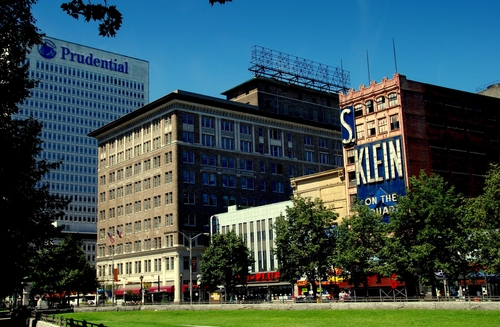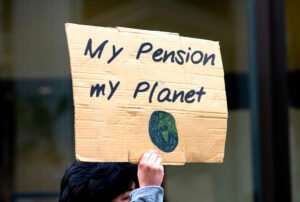
LEE SNIDER PHOTO IMAGES / Shutterstock.com
March 19, 2015; Politico Magazine
Two seemingly unrelated articles appeared recently, but they meant a lot to us together. After 25 years at the Jessie Smith Noyes Foundation, including 15 as president, Vic DeLuca is retiring. The news appeared in the Village Green, the newspaper serving Maplewood, New Jersey, because besides being a foundation president, DeLuca also serves as Maplewood’s mayor.
At roughly the same time, Politico ran two articles on the future of Newark, New Jersey, one a profile of Mayor Ras Baraka, who succeeded now-senator Cory Booker in Newark’s City Hall, the other a lengthy feature on the possibility that Newark may be on the way to a long-awaited revival like that of Brooklyn.
There is an odd connection between the Politico pieces and the DeLuca news. Before the Noyes Foundation, before Maplewood, DeLuca was a VISTA volunteer assigned to work as a community organizer (in the days when national community service still included community organizing as a legitimate activity) for the Ironbound Community Corporation in Newark. After his stint with Ironbound as an organizer, DeLuca became its executive director.
Sign up for our free newsletters
Subscribe to NPQ's newsletters to have our top stories delivered directly to your inbox.
By signing up, you agree to our privacy policy and terms of use, and to receive messages from NPQ and our partners.
Ironbound Community Corporation is one of several significant, widely known community development corporations that held neighborhoods together and provided the underpinnings for Newark’s potential revival, whether as a New Jersey version of Brooklyn or, more likely, in a direction that is truly an identity of its own. As banks and corporations disinvested from Newark, and as Newark’s own population became mostly people of color (in 2010, over half black, about one-third Hispanic), it was community-based nonprofits that kept plugging away to protect and support its low- and moderate-income residents.
You wouldn’t know that from the Politico article. It is largely a paean to outside investors buying up large tracts of Newark land on the cheap, much like the kind of dynamic happening in some parts of Detroit. The linchpin of the revitalization story is a development conceived by developer Ron Beit, financed in part by Nicholas Berggruen, chairman of the Berggruen Holdings private equity firm, designed by world-famous architect Richard Meier, and significantly influenced by Booker, who as mayor began attracting investors and developers to invest in a city that had previously been an avatar of political corruption (Booker’s three predecessors as mayor had all been indicted on criminal charges while serving as mayor) and white flight (the non-Hispanic white population is a little over 11 percent as of the 2010 Census).
Ironbound, however, is one of several neighborhoods that have been helped, stabilized, and improved as a result of nonprofit community development corporations. The Ironbound Community Corporation has long played an important role in that neighborhood, a vibrant community in Newark’s East Ward known for its Portuguese (and Brazilian) population, its churrascaria restaurants, and annual Portugal Day festival. Other notable nonprofits include La Casa de Don Pedro, serving the predominantly Latino North Ward of Newark with a soup-to-nuts range of critical services (housing counseling, weatherization, early childhood education, immigration counseling, job development, and commercial strip development, just to name a few), the Unified Vailsburg Services Organization offering housing development and children and youth services programs, and New Community Corporation, whose accomplishments include a supermarket-anchored, CDC-sponsored inner city commercial shopping center that has been replicated around the country based on the NCC model, thousands of affordable housing units in the Central and West Wards of the city, and an array of workforce development and other social service programs.
These and other CDCs, usually dealing with recalcitrant city administrations, turbulent local politics, and skittish banks, have held not only their neighborhoods together, but the city as well. Beit and Berggruen wouldn’t have much of a community to invest in if these and other CDCs provided the infrastructure to help the low- and moderate-income, predominantly minority residents find affordable housing, job placements, and supportive services. Also important to note is that the Prudential Social Investment Program and the Victoria Foundation, to name two philanthropic institutions, provided consistent and deep support to the neighborhood revitalization efforts in Newark, sticking with some of these groups despite the ups and downs (expected and otherwise) they encountered trying to make things happen in their neighborhoods and beyond (La Casa and NCC, to name two, serve much broader geographies than just a few Newark neighborhoods).
That takes us full circle back to DeLuca, whose community organizing background is palpable in the grantmaking of the Noyes Foundation, particularly its commitment to funding grantees led by people of color, 64 percent of the Noyes grantees in 2013. But it also takes us back to the profile of Newark’s revival as well. At the 2013 ribbon cutting for the first phase of the Beit/Berggruen project, there were, according to Politico, protesters who chanted “We need real jobs” and questioned whether the city was going to provide resources for employment of neighborhood residents. Like Dan Gilbert’s purchasing or investing in 65 properties in downtown Detroit and moving his Quicken Loans operations into the city, the question about the revitalization of a place like Detroit or like Newark is whether the benefits will reach or even be targeted to the residents who have stuck it out and tried to maintain their neighborhoods despite decades of public and private sector neglect . In Newark, it will be the CDCs, invisible in the Politico coverage, that will comprise the community infrastructure to remind the mayor, city council, and the private equity arriviste that Newark’s neighborhoods cannot be shunted to the curb.—Rick Cohen
DISCLOSURE: Rick Cohen assisted La Casa de Don Pedro with its current multi-year strategic plan.












